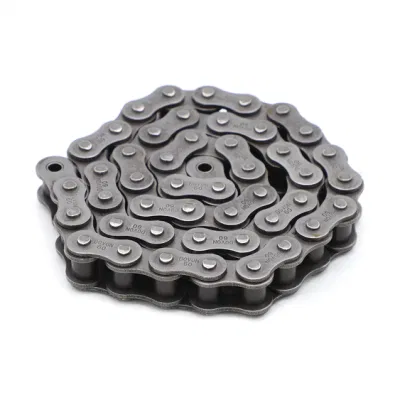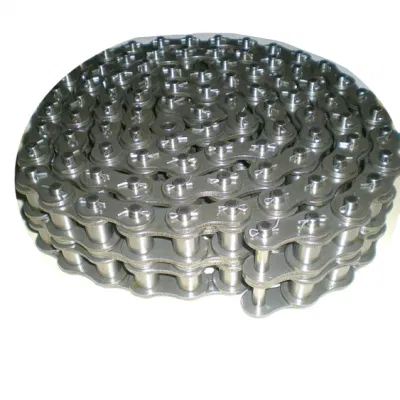Product Description
|
Chain No. |
Pitch
P |
Roller diameter
d1max |
Width between inner plates b1min mm |
Pin diameter
d2max |
Pin length | Inner plate depth h2max mm |
Plate thickness
t/Tmax |
Transverse pitch
Pt |
Breaking load
Q |
Weight per meter q kg/m |
|||||||
| Lmax mm |
Lcmax mm |
||||||||||||||||
| 08BSS-2 | 12.7-0-0. p. 211. Retrieved 17 May 2-0-0. p. 86. Retrieved 30 January 2015. Green 1996, pp. 2337-2361 “ANSI G7 Standard Roller Chain – Tsubaki Europe”. Tsubaki Europe. Tsubakimoto Europe B.V. Retrieved 18 June 2. External links Wikimedia Commons has media related to Roller chains. The Complete Xihu (West Lake) Dis. to Chain Categories: Chain drivesMechanical power transmissionMechanical power control Company Certificates Why Choose Us 1. Reliable Quality Assurance System 2. Cutting-Edge Computer-Controlled CNC Machines 3. Bespoke Solutions from Highly Experienced Specialists 4. Customization and OEM Available for Specific Application 5. Extensive Inventory of Spare Parts and Accessories 6. Well-Developed CHINAMFG Marketing Network 7. Efficient After-Sale Service System
How does a bush chain handle misalignment in a system?A bush chain is designed to accommodate a certain degree of misalignment within a system. Here’s how a bush chain handles misalignment: 1. Flexibility: The construction of a bush chain allows it to flex and adjust to minor misalignments. The bushings, which are inserted into the chain’s links, provide a degree of flexibility and allow the chain to move smoothly even when the sprockets are slightly misaligned. 2. Self-Alignment: The self-lubricating properties of some bush chains contribute to their ability to handle misalignment. The lubrication helps reduce friction and allows the chain to self-align by adjusting its position to minimize stress and binding caused by misaligned sprockets. 3. Tolerance for Misalignment: Bush chains are designed with specific clearance between the bushings and pins. This clearance provides some tolerance for misalignment. It allows the chain to accommodate slight angular or parallel misalignment between the sprockets without causing excessive wear or damage. 4. Compensation for Load Variances: In systems where load distribution is not uniform, such as conveyor systems, bush chains can help compensate for load variances. The flexibility of the chain allows it to adapt to changes in load distribution and adjust accordingly, reducing stress on the chain and sprockets. It is important to note that while bush chains can handle minor misalignment, excessive misalignment should be avoided. Excessive misalignment can cause accelerated wear, increased noise, and reduced chain life. Proper alignment and regular maintenance are essential to ensure optimal performance and longevity of the bush chain system.
What are the design considerations for a bush chain system?When designing a bush chain system, several key considerations should be taken into account to ensure its reliable and efficient operation. These design considerations include: 1. Load capacity: Evaluate the expected loads that the bush chain system will need to handle. Consider the weight, size, and type of materials or products being conveyed or transmitted. Select a bush chain with a suitable load capacity to ensure it can withstand the required loads. 2. Speed and acceleration: Determine the desired operating speed and acceleration of the bush chain system. This will influence the selection of chain pitch, material, and lubrication requirements. Higher speeds may require additional considerations such as reduced friction or increased precision. 3. Environmental conditions: Evaluate the operating environment for the bush chain system. Consider factors such as temperature, humidity, dust, chemicals, and presence of corrosive or abrasive substances. Select a bush chain material and coating that can withstand the environmental conditions and resist corrosion or wear. 4. Space limitations: Assess the available space for the installation of the bush chain system. Consider the dimensions and layout of the equipment, conveyor, or transmission system. Ensure that there is sufficient clearance for the chain’s movement and that the system can be properly tensioned and aligned. 5. Alignment and tensioning: Proper tensioning and alignment are critical for the smooth operation of a bush chain system. Design the system to include tensioners, idler sprockets, or adjustable mounting options to facilitate easy tensioning and alignment adjustments. 6. Lubrication and maintenance: Determine the lubrication requirements of the bush chain system. Consider the frequency and method of lubrication, as well as any accessibility constraints for maintenance. Select a lubrication method that suits the application, such as manual lubrication, automatic lubrication systems, or self-lubricating bush chains. 7. Safety considerations: Ensure that the bush chain system is designed with appropriate safety measures. Incorporate guards, covers, or enclosures where necessary to prevent accidental contact with moving parts. Consider emergency stop systems and safety interlocks for the protection of personnel and equipment. By carefully considering these design factors, a bush chain system can be optimized for performance, reliability, and longevity in a specific application or industry.
What are the different types of bush chains available?There are several types of bush chains available, each designed to meet specific application requirements. Here are some common types: 1. Standard Bush Chains: These chains have a simple construction with bushings and rollers. They are commonly used in general industrial applications that require moderate load capacity and speed. 2. Heavy-Duty Bush Chains: These chains are designed for applications that involve high loads, such as heavy machinery or equipment. They have a robust construction with thicker plates and larger diameter bushings to withstand the increased demands. 3. Extended Pitch Bush Chains: These chains have a larger pitch than standard chains, providing more space between each link. They are often used in applications that require conveying large or irregularly shaped objects, such as in material handling or packaging industries. 4. Double-Pitch Bush Chains: These chains have double the pitch of standard chains, allowing for longer spans between sprockets. They are commonly used in applications that require longer conveying distances or lower-speed operation. 5. Stainless Steel Bush Chains: These chains are made from stainless steel material, offering excellent corrosion resistance. They are suitable for applications in corrosive environments or industries with strict hygiene requirements, such as food processing or pharmaceutical manufacturing. 6. Self-Lubricating Bush Chains: These chains incorporate special materials or coatings that provide self-lubrication properties. They eliminate the need for external lubrication and reduce maintenance requirements. Self-lubricating bush chains are ideal for applications where regular lubrication is challenging or impractical. 7. Specialty Bush Chains: There are also specialty bush chains available for specific applications. These may include high-temperature chains, flame-resistant chains, or chains with specialized coatings for specific industries or environments. When selecting a bush chain, consider the specific requirements of your application, such as load capacity, speed, environmental conditions, and maintenance needs. Consult with a supplier or engineer to determine the most suitable type of bush chain for your application.
| ||||||||||||||||




